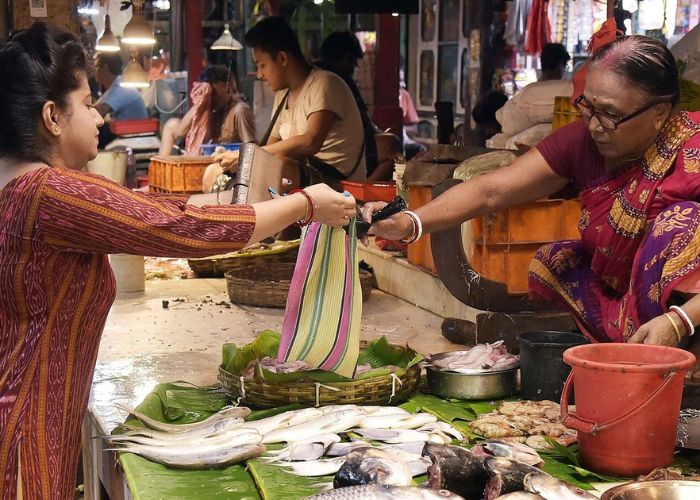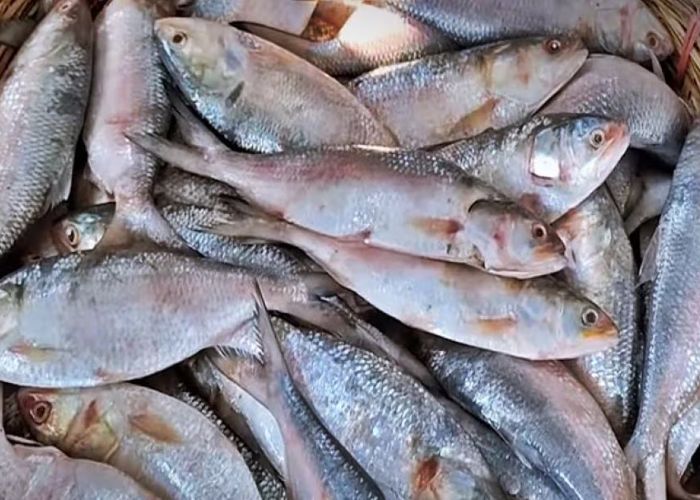As the auspicious Hindu festival of Durga Puja approaches, Bangladesh has lifted its ban on hilsa fish exports to India. This move comes as a relief to fish traders and exporters on both sides of the border who have been impacted by the export restrictions in recent years. Read below about “Bangladesh Lifts Hilsa Fish Export Ban to India Ahead of Puja”.
In this article, I will provide an in-depth perspective on this development as an industry expert with over 7 years of experience in the fisheries sector. Having worked closely with stakeholders across the value chain, I have witnessed first-hand how the hilsa fish holds cultural and economic significance for the region.
Table of Contents
The Hilsa Fish: A Delicacy and Livelihood Source
Hilsa, or Ilish as it is known locally, is a species of fish found in rivers, estuaries and seas mainly in Bangladesh, India, Myanmar and Pakistan. It has a distinct taste and texture that has made it immensely popular, especially in West Bengal and Odisha.
In fact, hilsa constitutes nearly 12% of fish production in India and over 13% in Bangladesh. For centuries, fishing for hilsa has supported livelihoods of poor communities living along the river banks. The onset of the monsoons signals the start of the peak hilsa fishing season, which continues till the Durga Puja festivities.
Given the high demand and lucrative market price, hilsa fishing provides important supplemental income for small-scale fishers. It is estimated that nearly half a million fisherfolk in Bangladesh depend on hilsa for employment and income generation. The wholesale export trade in hilsa is also a thriving industry in Bangladesh.
The Significance of Hilsa During Durga Puja
In Bengal, hilsa fish has deep cultural and religious connotations associated with the Durga Puja festival. It is considered as a shoja or favorite fish of Goddess Durga. Bengali households prepare a variety of hilsa delicacies like fried hilsa, hilsa steaks, hilsa roe, and more during this time.
In fact, the fish markets of West Bengal stock up on hilsa well in advance to cater to the surge in demand during Puja. Given the auspiciousness attached to hilsa, it is also bought as gifts for friends and family. Many community Puja pandals include hilsa fish in the bhog or offering to the Goddess.
For the Bengali community, the festival is incomplete without savoring hilsa-based delicacies. This cultural significance and religious sentiment make the availability of hilsa crucial for the Puja celebrations.
The Ban on Hilsa Exports to India

In an effort to conserve declining hilsa stocks and control domestic inflation, the Bangladesh government had banned exports of hilsa to India multiple times in the last decade.
The first ban was imposed in 2012 for a few months. After a one-year respite, the ban was re-imposed in 2014 and has largely remained in effect until now. However, short-term relaxations of 2-3 months have been permitted occasionally keeping in mind religious occasions and cultural sensitivities.
The export restrictions significantly curtailed the trans-boundary hilsa trade between India and Bangladesh valued at approximately INR 2000 crores. It caused losses to the fishing industry and angered traders on both sides.
Smuggling networks emerged along the porous border trying to meet the consistent Indian demand. Occasional seizures of illegally transported hilsa consignments have taken place over the years.
Lifting of Export Ban in 2022
As West Bengal gears up for Durga Puja festivities next month, Bangladesh has lifted the ban on hilsa exports to India from September 15 onwards. The decision brings cheer to the community and allows traders to legally export hilsa after nearly 2 years.
Earlier in April, a similar but short-lived relaxation permitted hilsa exports during the Bengali New Year. This time, the exports are expected to continue for longer catering to Puja demand.
The Bangladesh government has set an export quota of 100 metric tonnes of hilsa for the September to October period. To prevent overfishing, only hilsa exceeding 1 kg in weight will be exported.
The resumption of official exports is a positive sign for the struggling fishing industry. It will allow traders and exporters to recoup some of their COVID-induced losses.
Impact on Fishing Communities and Industry
The lifting of the ban ahead of Puja bodes well for the impoverished fishing communities and small-scale fishers. The export demand from India will incentivize higher hilsa catch. It will translate into better incomes, livelihood security and welfare for fisherfolk who have borne the brunt of the restrictions.
The traders and export industry also stand to gain with the added window for cross-border hilsa trade. The pent-up demand from India will fetch higher prices benefitting the export value chain.
However, concerns regarding long-term hilsa conservation cannot be ignored in the enthusiasm for short-term profits. Unregulated and unsustainable fishing driven by export targets can threaten the hilsa population which is already under stress.
Moreover, increased exports might reflect in short supply and higher hilsa prices in Bangladesh domestic markets. The government will have to ensure balance between export earnings and domestic affordability.
The Road Ahead
The hilsa export policy dilemma highlights the need for bilateral cooperation between India and Bangladesh to find a win-win solution. One approach could be exploring alternative hilsa fishing grounds to take the pressure off common rivers.
Joint research on hilsa migration patterns and scientific stock assessment methods is imperative. Simultaneously, supporting fisherfolk with livelihood diversification and hilsa aquaculture can reduce dependence on capture fishing.
Investing in traceability technologies like blockchain and following best practices around quality control and sustainability certifications can add value to the hilsa trade.
As an expert, I believe a coordinated strategy covering conservation, livelihoods and trade facilitation is the need of the hour. The cultural and economic stakes are far too high for both countries to let this delicate fish slip away.
The lifting of the ban ahead of Durga Puja opens up possibilities. With a spirit of shared responsibility, India and Bangladesh can not only save the hilsa but also harness its full potential to uplift fishing communities. The Hilsa fish exemplifies the deep bonds between the two countries – bonds that can be fortified through ecological stewardship and mutual understanding. I hope you like reading “Bangladesh Lifts Hilsa Fish Export – to India Ahead of Puja”.

Marta, the driving force behind WaterWorldCraze.com, holds a Master’s degree in Marine Biology and has extensive experience in water sports and activities. With over 7+ years of hands-on experience in marine research and conservation, she has participated in numerous underwater expeditions and projects. Her passion for the aquatic world shines through in her expertly curated content. Join Marta as she explores the wonders of marine life and shares her adventures. Connect with her on Instagram @marinebiologymarta for more insights and updates.

